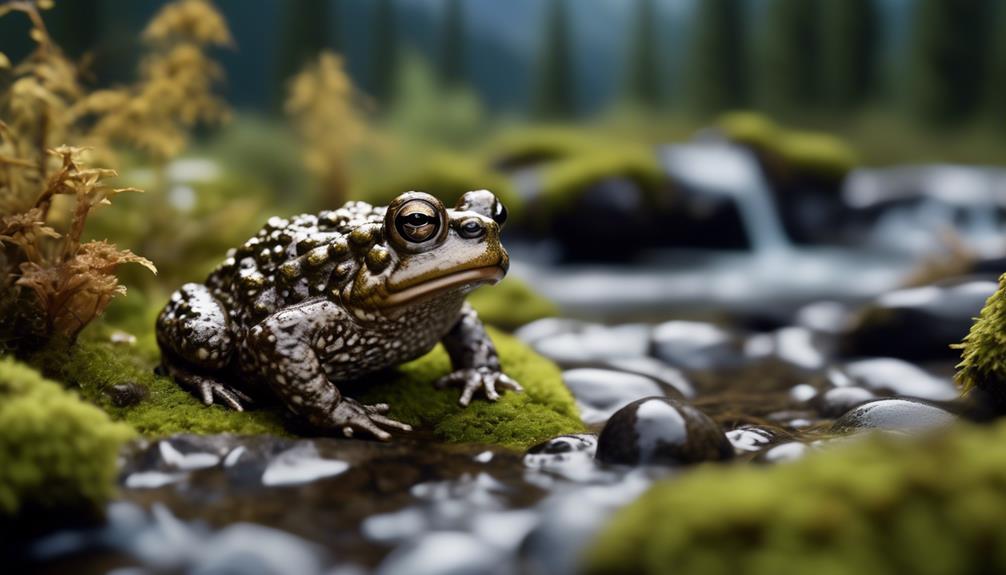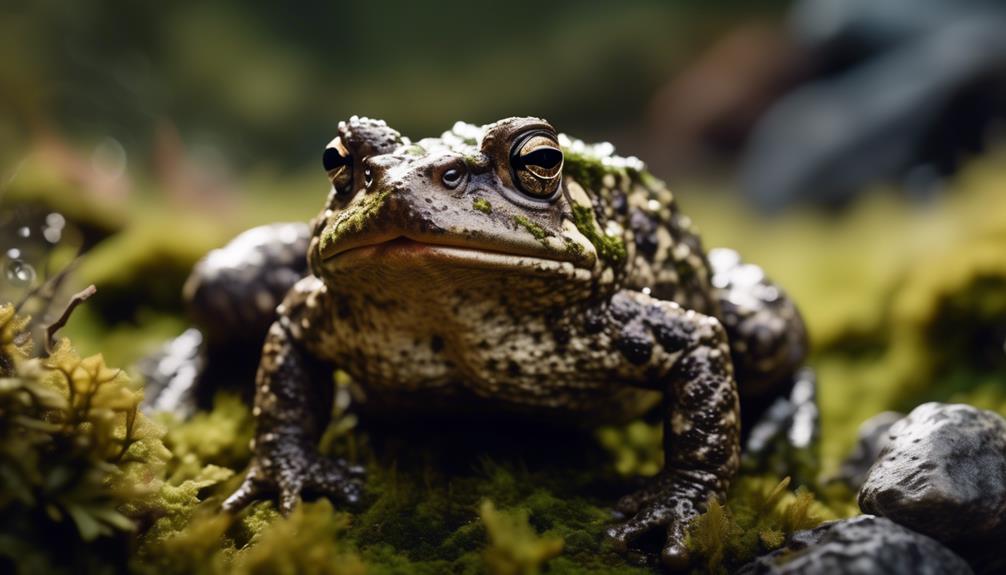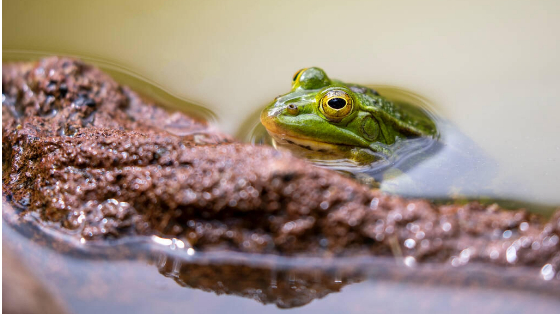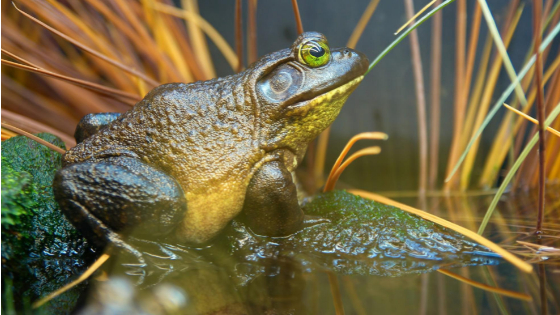
The Western toad, also known as Anaxyrus boreas, is a remarkable amphibian species that dwells within the awe-inspiring Rocky Mountains. Its unique physical characteristics and elusive nature have captured the attention of researchers and nature enthusiasts alike.
With its distinctive white or cream dorsal stripe and dusky gray or greenish coloration, the Western toad stands out amidst its surroundings. But there is more to this creature than meets the eye. Its oval parotoid glands, larger than its upper eyelids, serve as a defining feature.
This intriguing creature can be found in diverse habitats such as aspen groves, riparian forests, and alpine meadows, showcasing its adaptability. Its life cycle, habitat preferences, and conservation status will all be explored in this discussion, shedding light on the significance of preserving this Rocky Mountain treasure.
Key Takeaways
- The Western toad is found in the Rocky Mountains, with optimal habitats including aspen groves, riparian forests, and wet/dry mountain meadows.
- It has distinguishing features such as a white or cream dorsal stripe, oval parotoid glands, and larger parotoid glands than upper eyelids.
- Breeding activity of Western toads is correlated with warming weather and snowpack melting, with eggs laid in gelatinous strings in open water.
- The species faces concerns related to disease (chytridiomycosis) and chemical contamination, but is currently listed as a species of least concern.
Physical Characteristics
The physical characteristics of the elusive Western toad are distinctive and play a crucial role in its identification and classification within the Anaxyrus boreas species.
This toad species can be identified by its white or cream dorsal stripe and its dusky gray or greenish dorsally, with skin glands concentrated within the dark blotches. Notably, it has oval, widely separated parotoid glands that are larger than its upper eyelids.
During the breeding season, males have smoother skin, reduced dorsal blotching, and nuptial pads. Juveniles, on the other hand, exhibit a weak or absent dorsal stripe and prominent dorsal and ventral spotting, with yellow feet.
These physical characteristics, along with other distinguishing features, help researchers and experts classify and differentiate the Western toad from other subspecies within the Anaxyrus boreas species.
Distribution and Habitat

The range and habitat of the elusive Western toad are integral factors in understanding its distribution within the Anaxyrus boreas species.
The Western toad can be found in a wide range of habitats, from the Rocky Mountains in aspen groves and riparian forests to wet/dry mountain meadows or riparian deciduous forests with open water in California. They can also be found in various woodland types, sedge meadows, aspen-willow groves, and creosotebush communities.
In the Pacific Northwest, they occur in mountain meadows and Douglas-fir forests. The Western toad is a terrestrial species that spends its daylight hours on the forest floor, seeking hiding cover such as rocks, logs, stumps, or rodent burrows.
Their adaptability to different habitat types allows them to occupy a variety of geographical locations.
Life Cycle and Reproduction

The life cycle and reproductive behavior of the elusive Western toad include distinct characteristics and adaptations that facilitate successful breeding and survival in their diverse habitats.
- Oval parotoid glands are distinguishing features.
- They are active from January to October and hibernate over winter.
- Breeding age for males is three years in central Oregon.
- Breeding activity is correlated with warming weather and snowpack melting.
- Eggs are laid in gelatinous strings in open water from February to July, with hatching times varying.
During their life cycle, Western toads rely on their unique adaptations to ensure successful reproduction. The oval parotoid glands serve as distinguishing features of these toads. They are active for most of the year, hibernating over the winter months. Breeding age for males typically occurs after three years of age in central Oregon. The timing of breeding activity is closely correlated with the warming weather and the melting of snowpack. Female toads lay their eggs in gelatinous strings in open water from February to July, with hatching times varying depending on environmental conditions.
These reproductive behaviors and adaptations contribute to the survival and population maintenance of the Western toad in its diverse habitats.
Cover Requirements and Predators

During their life cycle, Western toads rely on specific cover requirements and face various predators that pose challenges to their survival and population maintenance.
Western toads are terrestrial and spend their daylight hours on the forest floor. They seek hiding cover such as rocks, logs, stumps, or rodent burrows to protect themselves from predators. If hiding cover is lacking, they may spend most of the day in water.
Western toads prey on bees, beetles, ants, arachnids, crayfish, sow bugs, grasshoppers, trichopterans, lepidopterans, and dipterans. However, they also face predation themselves. Tadpoles are preyed upon by fish, reptiles, amphibians, birds, and mammals. Adult western toads produce skin toxins that deter many predator species, and their nocturnal habit may help reduce predation.
Common ravens, other birds, reptiles, amphibians, and mammals are known to prey on adult western toads.
Conservation efforts are important to ensure the survival of this species.
Conservation Status

The conservation status of the Western toad is currently a topic of concern due to potential threats such as disease and chemical contamination. Some of the main factors contributing to the conservation status of the Western toad include:
- Disease: Chytridiomycosis, a fungal disease, poses a significant threat to the Western toad population. Outbreaks of this disease have been observed in various parts of their range, leading to declines in population numbers.
- Chemical contamination: The overuse of urea as fertilizer can have detrimental effects on Western toads. Chemical contaminants can accumulate in their habitat, leading to health issues and reduced reproductive success.
- Habitat loss: The destruction and fragmentation of their habitat, such as aspen groves and riparian forests, can negatively impact Western toad populations.
- Climate change: Changes in temperature and precipitation patterns can affect the breeding success and survival of Western toads.
- Predation: Common ravens, reptiles, amphibians, and mammals are known predators of Western toads, and increased predation pressure can further endanger their populations.
Efforts are being made to monitor and protect the Western toad population, including habitat conservation, disease management, and reducing chemical contamination in their environment.
Frequently Asked Questions
What Is the Average Lifespan of a Western Toad?
The average lifespan of a Western toad is not explicitly mentioned in the given information. Further research is needed to provide a specific answer to this question.
How Do Western Toads Defend Themselves Against Predators?
Western toads defend themselves against predators through a variety of mechanisms. They produce skin toxins that deter many predators, seek hiding cover, and have a nocturnal habit that helps reduce predation. They also have basking and evaporative cooling behaviors to control their body temperatures.
What Is the Main Threat to the Western Toad Population?
The main threat to the western toad population is the impact of disease and chemical contamination, particularly chytridiomycosis. Concerns also exist regarding the overuse of urea as fertilizer, which can harm the toads.
Are Western Toads Found in Any Other Regions Outside of North America?
Yes, Western toads are found in regions outside of North America. Their range extends from western British Columbia and southern Alaska to northern Baja California, Mexico. They have also been reported in Yukon Territory, Northwest Territories, and northwestern/north-central British Columbia.
Do Western Toads Have Any Unique Behaviors or Adaptations That Help Them Survive in Their Habitat?
Western toads have several unique behaviors and adaptations that help them survive in their habitat. These include their ability to secrete skin toxins, their nocturnal habits, and their use of hiding cover to avoid predators.
What is the significance of Western Toads in the Rocky Mountains compared to Colorado River toads?
The Colorado River toad article discusses the importance of Western toads in the Rocky Mountains versus Colorado River toads. While both species contribute to the ecosystem, Western toads play a significant role as a bioindicator for the health of the environment in the Rocky Mountains.
Conclusion
In conclusion, the Western toad is a captivating amphibian species found in the Rocky Mountains. It has distinct physical characteristics and habitat preferences. Despite being currently listed as a species of least concern, concerns about disease and chemical contamination pose potential threats to its population.
Preserving the Western toad’s habitat and implementing conservation measures are crucial in ensuring the survival of this elusive and valuable Rocky Mountain treasure.



